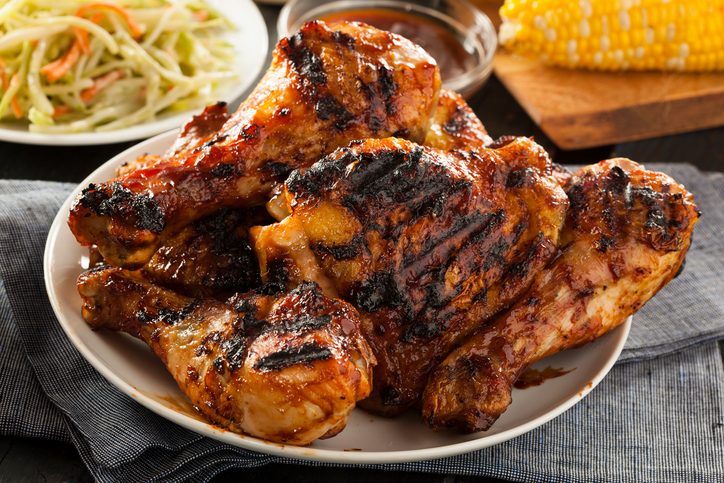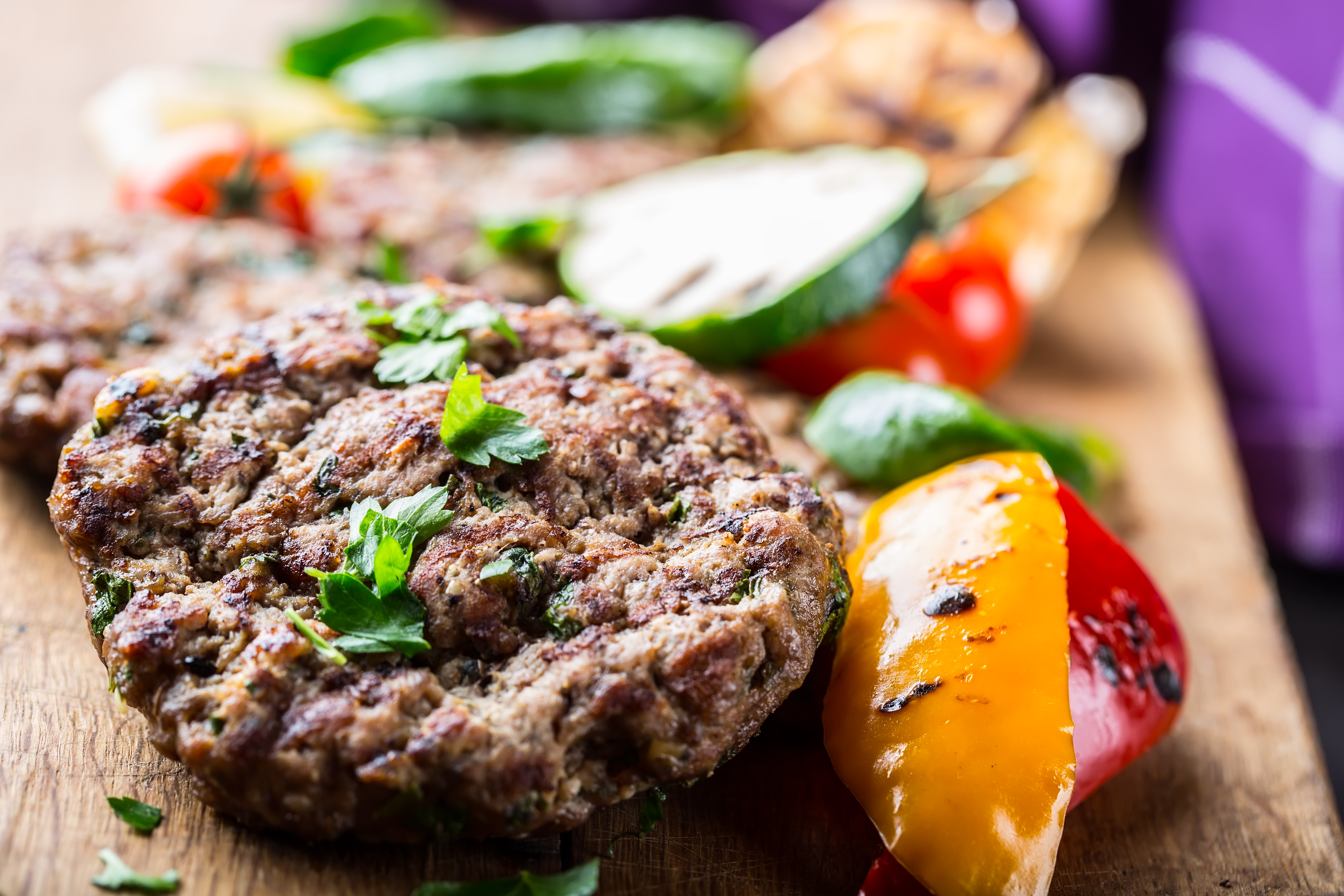
It’s mid-September and time to bid a slow farewell to summer, reluctantly pack away our grills, and turn our thoughts to the pleasures of fall. In come the pumpkins, the pies, and the apple cider, and out go the burgers and dogs of summer barbeques. We’ll miss them, but they’ll be back next year.
And they might be bigger and better by then.
Why? Because the ingredients we’re using to create those delicious meat patties slathered in cheese, onions, and pickles are changing. It’s a quiet revolution, a slow but steady evolution. Those burgers are no longer necessarily pressed from fatty ground meat. They look like regular old burgers, taste like regular old burgers, and if you didn’t know they weren’t the ‘real thing’ you wouldn’t be able to guess. Vegan, plant-based burgers and dogs are taking over your grill, alongside what is increasingly being called ‘slaughter-free meat’ – meat grown in a lab from stem cells. And the newest generation of these foods all started out with a single white feather. We’ll come back to this…
According to the United States Department of Agriculture (USDA), the average American consumes approximately 71 pounds of red meat, and a total of 265 pounds of all meats combined per year. This is more per capita than any other country and yet some projections see the figure set to rise still further. A report by the Organization for Economic Cooperation and Development cited in The Washington Post, estimates that ‘the demand for meat in North America will increase by 8 percent between 2011 and 2020, in Europe by 7 percent and in Asia by 56 percent.’(1) And with more of us eating meat, the environmental, health, and resource allocation problems will continue to deepen and cause even greater impact.
Meat production involves severe environmental impacts, a strain on natural resources, economic hardship for developing countries, unconscionable cruelty to the animals, and a multitude of challenges to human health and indeed survival, but is the only alternative a meat-free diet? Although the plant-based options today are broader, tastier, and more healthy than ever, there may be a third way: lab-grown meat. Depending on who you ask, this latest innovation is either a big gun in the Battle of the Frankenfoods or the key to solving myriad environmental, logistical, ethical, and health issues. But what is it and how do we grow it?
In essence, meat and seafood are just combination of cells – muscle and fat – that use nutrients to grow.
In an animal, the nutrients are provided through the diet, and in the lab, they’re provided as water, sugars, amino acids, lipids, vitamins, and minerals. In contrast with already popular plant-based options such as Beyond Meat’s product line which, although composed of soy and pea protein, is eerily reminiscent of its animal-based analogs, lab-grown meat is derived from actual animal cells. In 2013, Professor Mark Post of Maastricht University in the Netherlands used bovine stem cells to grow more than 20,000 muscle fibers during a twelve-week experiment. Developed in a gel growth matrix, the fibers grew into hoop-shaped filaments that, once mature, were cut open and straightened out. At this stage they measured around 2 centimeters in length by 1 centimeter wide and, with their ghostly white color, looked more like calamari than beef. That said, once pressed together to form a burger patty, the result was biologically identical to beef but slaughter-free.
And on this side of the Pond, several companies are doing similar work. Modern Meadow, for instance, is the brainchild of University of Minnesota researcher Andras Forgacs whose background in 3-D bio-printing of fully-functional livers and kidneys enabled the move into the clean meat arena. Seeing lab meat as a ‘longer-term opportunity,’ Forgacs is spearheading the use of additive manufacturing technologies to create layers of ‘bio-ink’ to build burgers and later perhaps even steak.(2) Burgers are easier to develop as the small scraps of muscle can be compressed to form the product where steak would require a more convoluted process. The average piece of sirloin contains blood vessels, fat deposits, and a more complex matrix of tissue designed to sustain the animal’s body and all of these components contribute to the texture, appearance, and taste of the food.

But it’s not all about beef. Remember that earlier reference to a single white feather?
Having realized that clean meat could be created from cells alone, Hampton Foods – a San Francisco, CA, startup co-founded by Josh Tetrick – sourced what they called ‘the single best chicken’ they could find. Collecting a dropped feather from Ian, a four-month old Cornish/Rock cross, the team identified the cell to use as their starter material introducing it to a cocktail of plant-based nutrients that allowed it to multiply quickly and to high density. The process is similar to the way in which beer is brewed, yeast is grown for bread-making, or enzymes are used in cheese production. It is high quality, clean, safe, and scalable. And Ian’s cells offered an outstanding performance. Hampton Creek’s ‘Chef de R&D,’ Thomas Bowman, took the first batch of lab-meat and created a prototype ‘chicken nugget’ in a process that was over 10 times more efficient than the highest volume slaughterhouse, resulted in a fraction of the greenhouse gas emissions associated with conventional production, showed significant reductions in land and resource usage, and involved no animal loss of life.(3)
So is this a niche market? The answer to that question is a solid No. In 2016, New Harvest, a 501(c)(3) that works to address food insecurity by promoting ethical and clean meat, hosted the first Cellular Agriculture Conference in San Francisco, CA. With speakers such as plant-based darlings Joshua Katcher of The Discerning Brute and Camille Delebecque of Afineur (who we met in our earlier article, ‘Is the World’s Most Expensive Cup of Coffee Worth It?’) and exhibitors such as Memphis Meats, Soylent, Clara Foods, Real Vegan Cheese, and Gen9 (to name just a handful), the dynamic conference revealed an excitement at the potential of the market. And figures from Food Business News seem to justify the excitement. In last year’s review of Natural Products Expo East in Baltimore, writer Monica Watrous noted that the ‘plant-based food and beverage market now exceeds $4.9 billion in U.S. sales, growing 3.5% since last year and outpacing the total food and beverage industry.’(4) And to contextualize this upward trend, growth in the total food and beverage industry is estimated at only 1.7% for the same period. Daiya, for instance, a company that produces non-dairy cheeses, yoghurts, pizzas, and desserts currently generates more than $100 million in revenue, selling to more than 35,000 stores nationwide. And sales of plant-based ‘meat alternatives’ from companies such as Beyond Meat, Upton’s Natural, Tofurkey, and Field Roast, increased by 3.8% to more than $595 million in annual sales.
Eyeing these market upswings, investors have been quietly pouring money into incubating start-ups, bolstering existing businesses, and moving animals off the table.
Memphis Meats, for instance, just received a large injection of funding from, among others, Sir Richard Branson, billionaire entrepreneur behind the Virgin Group. Forming part of a group that contributed a $17 million investment in the company, Branson went on record as expecting to see a meat-free world within the next three decades. ‘“I’m thrilled to have invested in Memphis Meats […] I believe that in 30 years or so we will no longer need to kill any animals and that all meat will either be clean or plant-based, taste the same, and also be much healthier for everyone,”’ he said in an article in Bloomberg News.(5) And Branson is not alone. In the same round of funding, Bill Gates, philanthropist and co-founder of Microsoft, also bolstered the coffers of the clean meat company, along with Cargill Inc., one of the world’s largest agricultural companies. Memphis Meats produces food from animal cells – creating a line of chicken, duck, and beef products without the slaughter of animals. Like Hampton Creek, the company makes its home in the San Francisco Bay Area and is able to tap into the Silicon Valley investor community. Interestingly, Kimbal Musk – entrepreneur, philanthropist, and restaurateur – is also involved in this venture. And if the name sounds familiar, it should: Kimbal is the brother of Tesla and Hyperloop visionary, Elon Musk.
So with all of this funding and support, what stands in the way of cultured meat? Perhaps the most significant challenge is that of gaining wider public acceptance. Despite support from its big name backers, lab-grown meat has yet to throw off its ‘ick factor,’ with many potential consumers continuing to prefer ‘the real thing.’ But as Professor Mark Post commented in an article for The Guardian, ‘Laboratory-grown beef: meat without the murder, but would you eat it?’, the ‘ick factor’ certainly exists in the production of conventional meat: “[It’s] a balancing act between the gut-feeling objection against it, and the rational acceptance that we cannot continue doing what we’re doing right now.”(6) But The Good Food Institute, a non-profit organization that advocates for plant-based and clean foods, may be a powerful voice in enabling greater acceptance. Founder Bruce Friedrich sees cellular agriculture and clean meat as a way to dissolve this ‘ick factor’ and ‘“remove ethics from the equation altogether for consumers [who] make their food choice decisions almost totally based on taste, price, and convenience.”’(7)
And public acceptance will increase as governmental oversight and regulation comes into play.
Currently, the landscape is somewhat uncertain as these new foods are uncharted territory. At this time, a tension exists between the USDA and the FDA over which agency should regulate the developing industry. Historically, the former oversees meat and egg production, whilst the latter is responsible for ensuring the safety of products made from cells or tissues. So, the regulations that would need to be applied to lab-grown meat products are USDA-based and founded upon the assumption that meat is derived from animal slaughter so. However, this new generation of foods – although animal-derived in the strictest sense – do not fall under the auspices of the existing regulation. As substances that are grown on a synthetic scaffold, they’re not classed as ‘food’ but also they’re also not considered ‘food additives.’ As Nicole Negowetti of the Good Food Institute notes: “USDA regulations are based on food from animal slaughter, so [they don’t] make sense for these products.”(8)
In fact, it is even more complex that just the food/food additive discussion. Given that these meats come from cell cultures formulated and developed in cleanroom environments, regulation could – theoretically – come under the same umbrella as that of drug manufacturing and therefore fall under the umbrella of FDA regulation. Since the FDA defines anything that contains human cells or tissues as a drug – and it’s not a huge leap to see that the rules applied to materials using human cells could be equally applicable to those developed from other cellular derivatives. But given that the industry is still in its infancy, the truth is that no-one as yet really knows where the responsibility for oversight lies. In 2016, the White House began a review of how federal agencies should regulate agricultural biotechnology, with a panel from the National Academies of Sciences, Engineering, and Medicine, based in Washington, D.C. releasing its report in March of this year.(9) This may help to demystify governmental control moving forward.
‘Clean,’ ‘lab-grown,’ ‘synthetic,’ ‘plant-based,’ ‘alternative,’ or ‘cultured,’ or whatever you call it, animal-free meat is the newest disruptive technology to shake up and transform the conventional agricultural paradigm.
Moreover, when it tastes as good as ‘the real thing’ without involving harm to the environment, our own health, or to the animals why wouldn’t we embrace it? From multiple perspectives – economic, environmental, and ethical – it’s clear that engineered meat offers a solution to feeding our increasing population, slowing the environmental devastation animal farming creates, and nurturing life in all its myriad forms. And, on a final note, if you’re wondering about the fate of Ian the chicken at the center of Hampton Creek’s cellular success, he is now living happily at Harvest Home Animal Sanctuary in Northern California. In accordance with its corporate philosophy of animal welfare, the company reached out to the sanctuary to provide a safe home for Ian in his retirement. And he is a perfect fit. Describing him as ‘a very sweet-natured, gentle guy,’ Christine Morrissey, the sanctuary’s Executive Director, explains:
“At our sanctuary, we focus on the care of individual animals. Ian is an ambassador for the billions of chickens killed for food each year. His unique story is changing the way people look at farmed animals. Undoubtedly, he is influencing not only the future of food but also building a more compassionate world.”
And all of this stems from the donation of a single white feather…
Do you have thoughts about lab-grown meat? We’d love to read your comments!
9/22/2017 Update: Clean Meat: Can a Flesh-Based Product Ever Be Considered Contamination Free?
References:
- https://www.washingtonpost.com/national/health-science/lab-grown-meat-is-in-your-future-and-it-may-be-healthier-than-the-real-stuff/2016/05/02/aa893f34-e630-11e5-a6f3-21ccdbc5f74e_story.html?utm_term=.61b265105d19
- http://www.businessinsider.com/modern-meadow-lab-grown-leather-2016-6
- To watch a video of Ian and the Hampton Creek team enjoying the nuggets go to: https://medium.com/hampton-creek/clean-meat-feeding-the-future-2636077ed906
- http://www.foodbusinessnews.net/articles/news_home/Consumer_Trends/2016/09/Expo_East_2016_Plant-based_a_p.aspx?ID=%7BD9098A27-0B58-4122-BAE2-5BC1AAFBFD98%7D&cck=1
- http://worldwatch.org/node/549
- https://www.bloomberg.com/news/articles/2017-08-23/cargill-bill-gates-bet-on-startup-making-meat-without-slaughter
- https://consciouscompanymedia.com/the-new-economy/technology-design/how-startups-and-nonprofits-are-collaborating-to-build-the-clean-meat-industry/
- https://www.theguardian.com/science/2014/jul/13/laboratory-grown-beef-meat-without-murder-hunger-climate-change
- Interested readers can purchase a copy of the full report here: https://www.nap.edu/catalog/24605/preparing-for-future-products-of-biotechnology



Pingback: Update: Clean Meat: Can a Flesh-Based Product Ever Be Considered Contamination Free? - Food Contact Surfaces
Pingback: Update - The Impossible Burger - Food Contact Surfaces
Pingback: Can a Flesh-Based Product Ever Be Considered Contamination-Free? - Berkshire Singapore
Pingback: Can a Flesh-Based Product Ever Be Considered Contamination-Free? - Berkshire Singapore
Pingback: How Recent Developments in Nutrition Inspire Innovation - Food Contact Surfaces
Pingback: How Bioreactors and Cleanroom Technology Might Be the Answer to Declining Seafood Stocks - Food Contact Surfaces
Pingback: Could Cell-Cultured Meats And Bioreactors Be The Next Step In Pet Food Safety? - Food Contact Surfaces